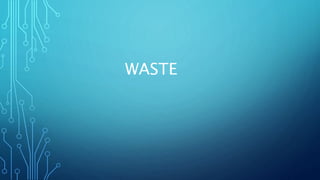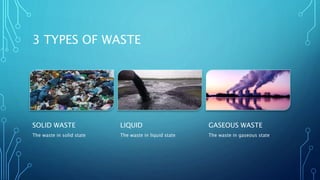Waste
- 1. WASTE
- 3. WASTE Waste are unwanted or unusable materials. Waste is any substance which is discarded after primary use, or is worthless, defective and of no use. A by-product by contrast is a joint product of relatively minor economic value.
- 4. 3 TYPES OF WASTE SOLID WASTE The waste in solid state LIQUID The waste in liquid state GASEOUS WASTE The waste in gaseous state
- 5. TYPES OF SOLID WASTE BIODEGRADABLE Biodegradable waste includes any organic matter in waste which can be broken down into carbon dioxide, water, methane or simple organic molecules by micro-organisms and other living things by composting, aerobic digestion, anaerobic digestion or similar processes NON-BIODEGRADABLE âĒ A Non-Biodegradable material can be defined as a kind of substance which cannot be broken down by natural organisms and acts as a source of pollution. ... Non- biodegradable wastes are those who cannot be decomposed or dissolved by natural agents. They remain on earth for thousands of years without any degradation.
- 6. WASTE MANAGEMENT WASTE MANAGEMENT INCLUDES THE ACTIVITIES AND ACTIONS REQUIRED TO MANAGE WASTE FROM ITS INCEPTION TO ITS FINAL DISPOSAL. THIS INCLUDES THE COLLECTION, TRANSPORT, TREATMENT AND DISPOSAL OF WASTE, TOGETHER WITH MONITORING AND REGULATION OF THE WASTE MANAGEMENT PROCESS.
- 7. WASTE MANAGEMENT To manage waste we should use the 3 râs
- 8. âĒ Reduce âĒ We need to reduce the amount of waste generated by consuming more and throwing away less. We often buy more things than we really need. Nowadays, disposable items have become popular, for example, ballpoint pen, plastic bag, disposable napkins etc. We are using them frequently without giving a thought to their hazardous effects. Here are some tips for reducing wastes: âĒ Use fountain pen in place of a ballpoint pen, âĒ Use old newspapers for packaging, and âĒ Use cloth napkins in place of disposable ones.
- 9. Reuse We can reuse certain things for more than one purpose. If we reuse them for other purposes, we can help in reducing the waste. Here are some of the tips for reusing things: Small jars and bottles can be cleaned to keep some other kitchen stuffs. One should prefer glass bottle to metal can when buying juice or soft drink. The bottles can be refilled. Old clothes can be made into other usable items like cushion cover, handkerchief, etc. Old mobile phones can be donated to friends or family
- 10. Recycle The process by which waste materials are used to make new products is called recycling. Materials like glass, metal, plastic, and paper are collected, separated, and recycled to make new things.
- 11. CONCLUSION âĒ We should recycle waste to have a clean life. âĒ We should use the proper recycling method for each one âĒ The more clean we are, the more age we live !!!!
- 13. THANKYOU












